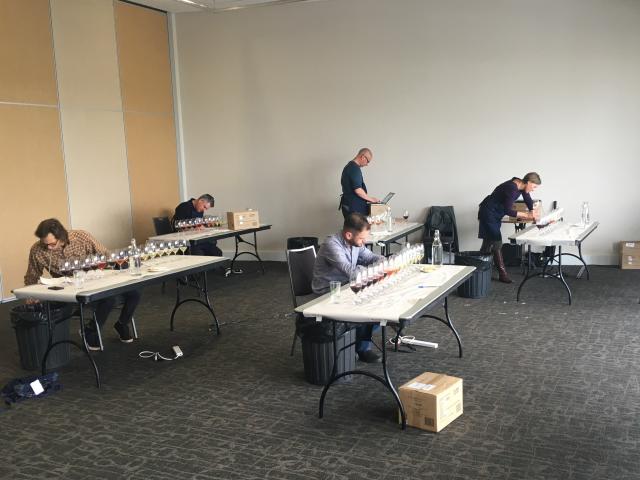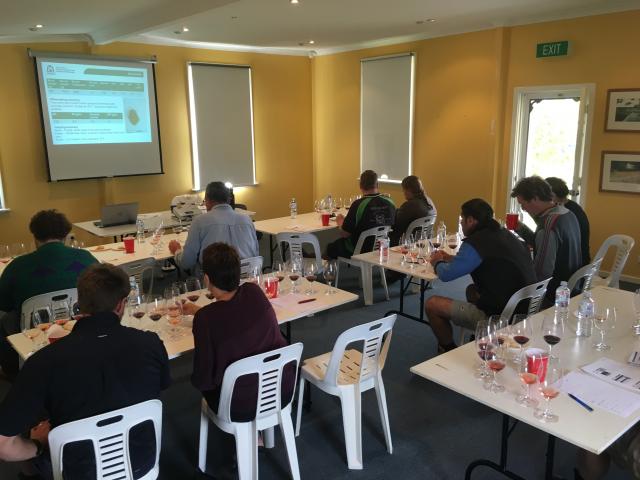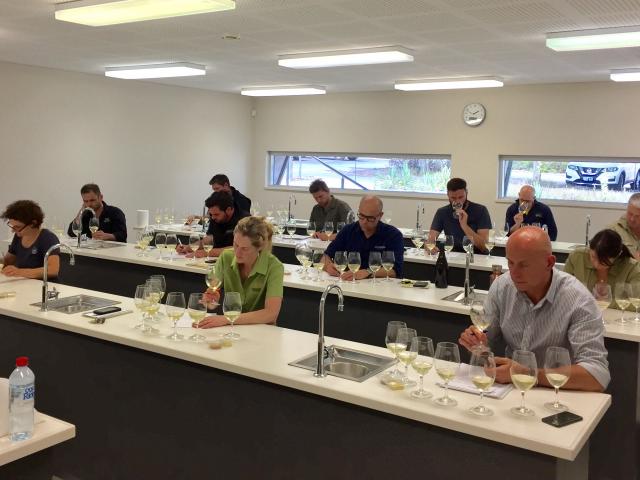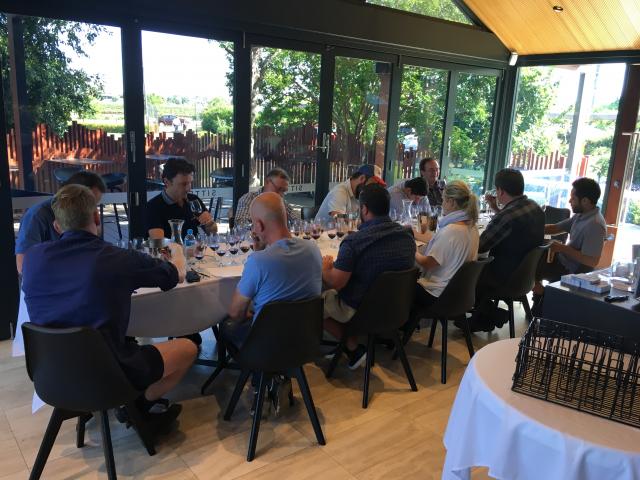Alternative varieties
Judging at Geographe Wine Show
At this year’s Geographe Wine Show, judges were presented with 16 unique wines produced from 13 different varieties grown at the alternative variety evaluation and demonstration block at Harvey Agriculture College.
The wines were made by Research Officer Richard Fennessy at the Department of Primary Industries and Regional Development’s (DPIRD) Bunbury wine laboratory.
Richard produced small scale batches (4.5 – 24L) utilising commercial winemaking techniques to optimise varietal expression.
The wines were judged in a unique class and the judges were not provided any information, other than they were made from an evaluation block near Harvey.
The judges were asked to describe the wines and score them.
| Variety (whites) | Score | Description |
|---|---|---|
| Pignoletto (sparkling) | 16.6 | Citrus and stonefruit aromas/flavours, zesty acid and textural. |
| Gruner Veltliner | 16.0 | Apples, pears, tropical and herbal notes on the aroma. Lime, pithy, white nectarine flavours with a tight acid structure. |
| Pignoletto | 16.3 | Vibrant lemon floral, mouthwatering acidity, citrus zest, green apple and textural. |
| Vermentino | 16.4 | Lime, lemon thyme, melon and floral aromas. Lively lime citrus with peach structured with chalky tannins. |
| Fiano | 16.9 | Lime, green tropical fruits and floral. Zippy and zesty with savoury textural elements and persistence. |
| Savagnin Blanc | 17.1 | Stonefruits, florals and saline characters on the nose. Orchard fruits, spice, citrus and savoury elements on the palate. |
| Arneis | 15.8 | Pear, peaches and mineral aromas. Crisp, bright with citrus and melon flavours. |
| Scheurebe | 17.4 | Pretty nose with exotic Asian fruits, florals and stonefruits. Bright acidity, fleshy and juice with white fruits, florals and tropical fruit flavours. |
| Variety (reds) | Score | Description |
|---|---|---|
| Dolcetto (rose) | 16.5 | Strawberry, rockmelon, floral and pear aromas. Crunchy acidity, chalky texture with red berry and pear flavours. |
| Sciacarello (rose) | 14.9 | Complex, savoury, spice and red berries with chalky phenolics. |
| Dolcetto | 16.4 | Perfumed, red fruits and spice with soft refined tannins. |
| Sciacarello | 16.4 | Savoury, melon, strawberry, spice and leafy aroma. Velvety tannins, savoury palate with melon and spice flavours. |
| Graciano | 16.3 | On the nose pepper, smoky, red fruits and plum. Fine soft tannins well concentrated with red berries and pepper flavours. |
| Tannat | 16.1 | Red and black berries, currants, floral and spice. Balanced grippy tannins flavours of spices, red and dark fruits. |
| Saperavi | 16.9 | Aromas of dark fruits, liquorice and plum. Concentrated palate with big gravelly tannins, forest fruits, spice and persistence. |
| Carmenere | 17 | Complex nose of pepper, violets, plum and herbs. Cherry, spice and savoury flavours supported by fine velvety tannins. |
Workshop series
All Western Australian regional wine industry associations were invited to express an interest in hosting presentations of the 2017 alternative wine varieties.
DPIRD Research Officer Richard Fennessy recently conducted workshops in Geographe and the Great Southern.
The first workshop held in Mt Barker on 24 October was attended by 12 local producers.
Richard said that the group was very interested to discuss which varieties would be most suitable to grow under local conditions that produce wine styles readily accepted by the market. Of the 13 varieties tasted, Gruner Veltliner and Dolcetto were the most preferred based on these criteria.
Richard presented the same workshop to a group of Geographe producers on 30 November.
The final workshop is scheduled for 23 January 2018 in Margaret River (see ‘Future events’ for full details).
For further information contact Richard Fennessy, Research Officer on +61 (0) 9780 6219.
Winemakers’ Trial Forum extends to the regions
The Winemakers’ Trial Forum which has been held in Margaret River since 2015 has been extended to also incorporate workshops in the Swan Valley and Great Southern, thanks to funding from the Wine Australia Regional Program.
This funding has also enabled a guest winemaker from outside the state to share experiences, techniques and technologies that may not be familiar to local winemakers at the forums.
Swan Valley
The first of three Winemakers’ Trial Forums was held in the Swan Valley on 3 November 2017.
Twelve local winemakers came together to discuss viticultural and winemaking approaches to three significant varieties for the region; Verdelho, Grenache and Shiraz.
The forum also featured Corrina Wright from Olivers Taranga in McLaren Vale who gave an interesting perspective of growing and making Grenache and Shiraz from McLaren Vale.
Some of the discussion points concerning Verdelho included:
- Fruit ripeness and impact on style.
- Degree of which the fruit is crushing and the impact on quality.
- Use of oak.
- The benefits of co-inoculation of different yeasts.
- Different approaches to fining were discussed and compared.
Some of the discussion points concerning Grenache included:
- Acknowledging the unique resource of old vines in the region.
- General discussion on style from a regional perspective.
- The impact of whole bunches in the ferment and various percentages.
- The importance of managing fermentation temperature.
- Oak handling and format.
Some of the discussion points concerning Shiraz included:
- How wines from a cool ferment (18-20C) compare to a warmer ferment (~25C).
- The effect of whole bunches on the resulting wine.
- The influence of soil type on wine attributes.
Margaret River
Thirteen winemakers shared different viticultural and winemaking trials at the Margaret River workshop held on 28 November 2017.
This is the third consecutive year that this workshop has been held in Margaret River, promoting innovation and collaboration within the region.
This year’s event featured guest wine maker Andrew Hales from Penfolds.
Andrew shared insight into Chardonnay and Cabernet production from a non-WA perspective, including detailing the clones sourced by Penfolds from premium wine regions in South Austraila and Victoria.
An interesting discussion covered the diversity of Cabernet clones in Coonawarra and how wine traits have been observed to differ between them.
Andrew also provided insight into how Penfolds manage their wines in barrels especially relating to storing them at 2 o’clock and minimal rackings during maturation.
Local winemakers presented four trials focussing on key varietals Chardonnay and Cabernet Sauvignon, including viticultural or winemaking treatments that aim to improve wine quality and production efficiencies.
The group tasted the wines ‘blind’, followed by a group discussion on differences and preferences of the various treatments.
Trials included:
- Chardonnay oak exchange
- Margaret River chardonnay clones
- Great Southern chardonnay clones
- Cabernet Sauvignon planting density and fermenter configuration
- Cabernet Sauvignon tannin trials
Chardonnay oak exchange
This innovative trial examined the impact of fermenting and maturing a parcel of Chardonnay and exchanging the wine into and out of new/old oak barrels over three separate time periods.
The aim was to demonstrate the impact and interaction that can be achieved by utilising old barrels with new barrels during the fermentation and maturation process.
The treatments were:
| Fermentation vessel | Maturation vessel | Timing of wine exchange |
|---|---|---|
| New barrel | New barrel | n/a (control) |
| Old barrel | Old barrel | n/a (control) |
| New barrel | Old barrel | Immediately after fermentation |
| Old barrel | New barrel | Immediately after fermentation |
| New barrel | Old barrel | 1 month after fermentation |
| Old barrel | New barrel | 1 month after fermentation |
| New barrel | Old barrel | 3 months after fermentation |
| Old barrel | New barrel | 3 months after fermentation |
The group didn’t have a clear preference between the control wines or those exchanged immediately after fermentation. They did however show a clear preference to the wines that had been fermented in new barrels and exchanged to older barrels after one or three months.
Overall the group agreed that this trial showed the significance of fermenting and storing Chardonnay in new barrels, but that integrating old barrels into the maturation process may contribute interesting blending options.
Margaret River Chardonnay clones
Five clones of Chardonnay grown in Margaret River were presented blind to the group. These wines were produced from the national research project ‘Assessing clonal variability in Chardonnay and Shiraz for future climate change’.
Clones 277 and Gingin were well received by the group, while 96 and 95 were the lesser preferred clones.
Great Southern Chardonnay clones
The wines produced from the same national trial were grown at a vineyard in Mt Barker.
The group found this bracket of wines difficult to distinguish by quality traits but there was a distinct variation in style.
Styles ranged from citrus/lime to a more stonefruit/orchard fruits flavour spectrum.
I10V1 was the least preferred clone which, in discussion, was attributed to the wine being lower in acidity than the other three clones and picked at a slightly higher Baume.
Cabernet Sauvignon planting density and fermenter configuration
A parcel of Cabernet (clone 126) was split and fermented in a small (2t) format custom built conical fermenter and a large (10t) conventional fermenter. These were tasted and compared.
Another parcel of Cabernet (Houghton clone) planted at high density (1m x 1.5m) was also split between these two fermenter configurations and presented to the group.
For both parcels the group preferred the wines fermented in the small fermenters (71% and 64% respectively) and the wines from the high density planting were greater in colour and concentration compared to the other parcel.
Cabernet Sauvignon ferment tannin trials
Different fermentation tannins were added to a parcel of Cabernet that was split into three tanks. The tannins Scott Tan FT Rouge, Incanto NC Rouge and VR Supra were added at ferment at similar rates to investigate the performance of the tannins.
There were clear differences between the treatments and overwhelmingly 79% of the group preferred the wine that had received the Incanto NC Rouge tannin addition. It was also noted that this tannin was the most expensive of the three.
The Department of Primary Industries and Regional Development intends to hold this forum on a regular basis to provide WA winemakers with the opportunity to share experiences and promote innovative approaches to improving production efficiencies and wine quality.
For more information contact Richard Fennessy, Research Officer on +61 (0)8 97 80 6219.
Register your sensitive site

Wine and table grape growers are being encouraged to register for the 2017/18 Sensitive Sites map service.
The Department of Primary Industries and Regional Development (DPIRD) provides this free service to show the location of known sensitive enterprises that could be negatively affected by activities on nearby properties.
This free service is designed to assist both sensitive commercial enterprises and nearby landholders in preparing risk assessment and mitigation plans for their activities to ensure these sites are protected.
For the purpose of the map on the website, a Sensitive Site is a property that needs special consideration due to the nature of the production system. Examples of Sensitive Sites include production certified as organic and/or biodynamic, certified aquaculture sites, viticulture, horticulture, commercial bee hive sites and managed tree and forestry nurseries.
Once a grower/producer has registered their property, DPIRD will verify that the property fits within the scope of a sensitive site before being included in the map.
DPIRD has requested all growers/producers currently registered as a Sensitive Site to update their property details if changed, and will advertise the dates of the registration period in the Countryman and Farm Weekly.
The registration period will close on 14 December 2017.
To register a property please send an email to sensitivesites@dpird.wa.gov.au
Interested growers without internet access can contact Dr Modika Perera on +61 (0)8 9368 3526.
Margaret River Cabernet wins Gladstones Trophy
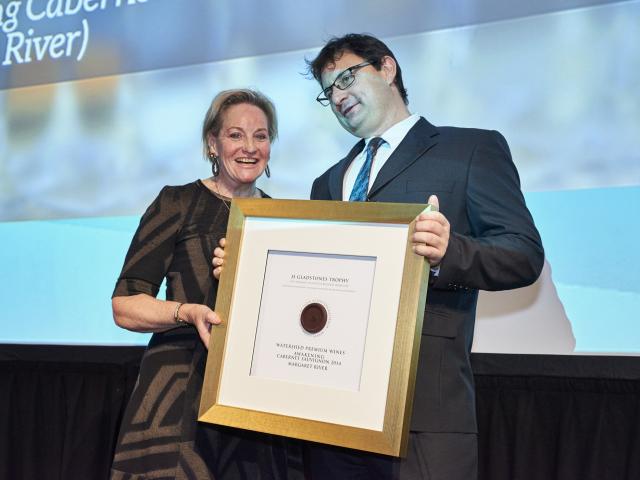
A Cabernet Sauvignon from Margaret River has won the JS Gladstones Trophy at the Wine Show of WA awards dinner for the wine showing the best and most distinctive regional character.
The trophy celebrates excellence in winemaking and recognises the contribution of former Department of Agriculture and University of Western Australia scientist, Dr John Gladstones, who identified the Margaret River region as the most suitable in Australia for viticulture and high quality wines.
Watershed Premium Wines 2014 Awakening Margaret River Cabernet Sauvignon took out the prestigious trophy, sponsored by the Department of Primary Industries and Regional Development, from a field of 12 finalists.
Department researcher and trophy tasting panel member, Glynn Ward, said the Margaret River Cabernet Sauvignon was recognised for showing the best expression of both the variety and region it represents.
“The 2014 Awakening Cabernet Sauvignon was harvested at optimum maturity with intense flavour and a deep-red/crimson-tinged colour,” Mr Ward said.
“The wine had complex blackcurrant, cassis, liquorice and hints of cigar box flavours, and velvety texture with fine tannins that are distinctive of Cabernet Sauvignon from the Margaret River region.
“It is a credit to the winemakers, Severine Logan and Conrad Tritt.”
Regional character is an important factor in marketing fine wine, particularly in taking full advantage of new export growth and wine-related tourism opportunities.
Mr Ward said the right variety and clone, grown in the right climate, region and site, create a perfect match.
“The production of fine wines in our nine diverse winemaking regions provides flow-on economic benefits from wine and food tourism in Western Australia,” he said.
“The department’s grape and wine team helps ensure the quality and distinctive character of WA’s wines continues to improve through research in new varieties, and better clones and winemaking techniques.
“Team members also work closely with the wine industry to assist producers to take full advantage of export growth opportunities.”
Sustainability and innovation grant
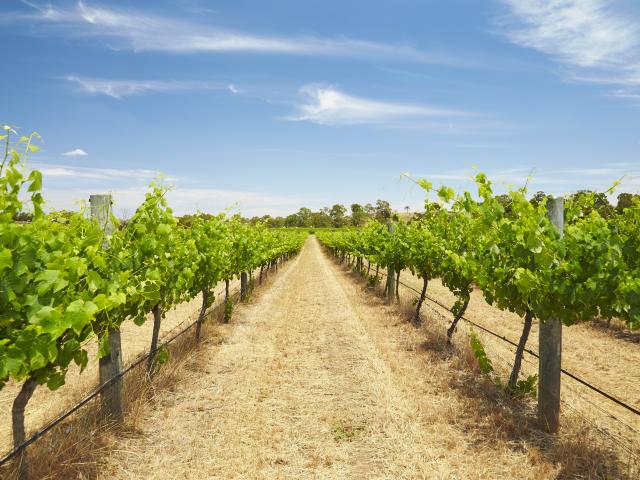
The Federal Department of Agriculture and Water Resources is currently offering grants to primary producers to develop, trial and implement new and innovative tools that support the uptake of sustainable practices.
This initiative is from the Smart Farming Partnerships grant program and provides grants from $250 000 to $4 million.
This is especially a great opportunity for wine producers to receive funding to allow the development of sustainable practices that protect and improve our resources of soil, water, plants and animals which underpin productive and profitable primary industries.
Grants are available to experienced and skilled organisations willing to work in partnership. Those eligible include public and private companies, incorporated associations, individual/sole trader and Local/State Government agencies.
Applications close 21 December 2017.
More information can be found at National Landcare Program Smart Farming Partnerships.
Future events
Alternative variety field walk
Approximately 80% of Western Australia’s wine grape production is comprised of five varietals.
Reliance on a small collection of varietals presents certain challenges, especially in terms of adapting to a changing climate and market trends.
Varietal selection is one tool available to address these challenges.
The Department of Primary Industries and Regional Development and collaborating partners invite you to inspect the performance of 22 varieties and discuss their suitability to WA growing conditions.
Information will be available on the background and characteristics of each of these varieties and a selection of trial wines produced will be available to taste.
The field walk is an ‘open house’, where you can make your own way through the block inspecting the performance of the vines at your leisure.
| When: | January 2018 (date to be confirmed) |
| Where: | WA College of Agriculture – Harvey, Mornington Rd, Wokalup WA 6221 |
| Cost: | Free to WA wine and grape producers |
| RSVP: | Please register your interest in attending by contacting Richard Fennessy, Research Officer +61 (0)8 9780 6219. |
Alternative varieties' tasting – Margaret River
During the 2016/17 season the Department or Primary Industries and Regional Development has been undertaking an evaluation and demonstration of a collection of alternative varieties grown at the WA College of Agriculture – Harvey.
Funding made available through the Wine Australia Regional Program has enabled researchers to collect viticultural data and make wine from 13 different varieties this season.
Utilising commercial techniques (i.e. yeast selection, oak, fermentation temperature, skin contact etc.) on small scale volumes, these wines enable producers to gain insight into their characteristics and suitability to local conditions.
Join Research Officer Richard Fennessy to taste 15 wines (some varieties have been made in multiple styles) and hear how the varieties performed.
Some of the varieties to be tasted include Grüner Veltliner, Vermentino, Saperavi, Dolcetto and Graciano.
| When: | 3.00 – 5.00pm Tuesday, 23 January 2018 |
| Where: | Sensory Lab, Margaret River Education Campus, Bussell Hwy, Margaret River WA 6285 |
| Cost: | Free |
| Registration: | Spaces are limited to venue capacity, RSVP to Richard Fennessy, Research Officer on +61 (0)8 97 80 6219 by 17 January 2018. |

